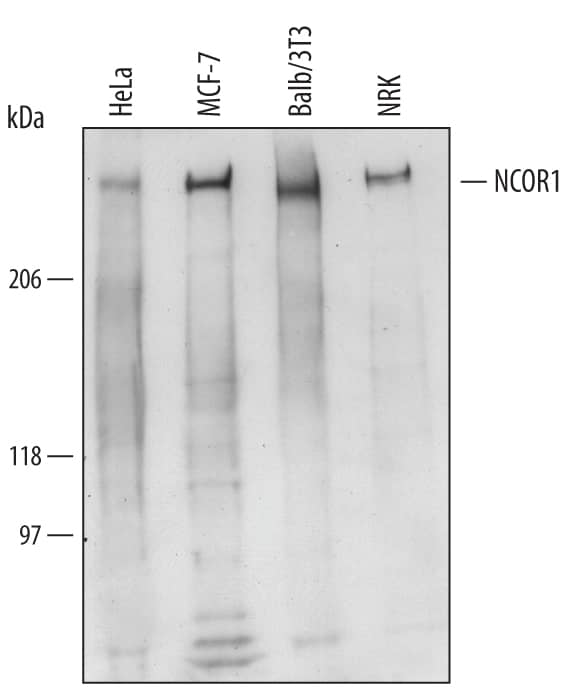Human/Mouse/Rat NCOR1 Antibody
R&D Systems, part of Bio-Techne | Catalog # AF6167

Key Product Details
Species Reactivity
Applications
Label
Antibody Source
Product Specifications
Immunogen
Gln1770-Ala1947
Accession # O75376
Specificity
Clonality
Host
Isotype
Scientific Data Images for Human/Mouse/Rat NCOR1 Antibody
Detection of Human, Mouse, and Rat NCOR1 by Western Blot.
Western blot shows lysates of HeLa human cervical epithelial carcinoma cell line, MCF-7 human breast cancer cell line, Balb/3T3 mouse embryonic fibroblast cell line, and NRK rat normal kidney cell line. PVDF Membrane was probed with 1 µg/mL of Sheep Anti-Human/Mouse/Rat NCOR1 Antigen Affinity-purified Polyclonal Antibody (Catalog # AF6167) followed by HRP-conjugated Anti-Sheep IgG Secondary Antibody (Catalog # HAF016). A specific band was detected for NCOR1 at approximately 270 kDa (as indicated). This experiment was conducted under reducing conditions and using Immunoblot Buffer Group 1.Applications for Human/Mouse/Rat NCOR1 Antibody
Western Blot
Sample: HeLa human cervical epithelial carcinoma cell line, MCF‑7 human breast cancer cell line, Balb/3T3 mouse embryonic fibroblast cell line, and NRK rat normal kidney cell line
Formulation, Preparation, and Storage
Purification
Reconstitution
Formulation
Shipping
Stability & Storage
- 12 months from date of receipt, -20 to -70 °C as supplied.
- 1 month, 2 to 8 °C under sterile conditions after reconstitution.
- 6 months, -20 to -70 °C under sterile conditions after reconstitution.
Background: NCOR1
NCOR1 (Nuclear receptor Co-Repressor 1) is a 270 kDa member of the NCoR family of molecules. It is widely expressed, being found in hepatocytes, intestinal crypt cells, neural stem cells, plus immature thymocytes and erythrocytes. NCOR1 is a transcriptional repressor. It forms a complex with HDAC3, TAB2 and ZBTB33, and interacts with a ligand‑independent THR:RXR heterodimer bound to select gene promoters. Human NCOR1 is 2440 amino acids (aa) in length. It possesses one N‑terminal repression domain (aa 1‑312), two DNA‑binding SANT domains (aa 437‑674) and a second repression domain (aa 737‑1004). Multiple Ser, Thr and Tyr phosphorylation sites exist that regulate complex dissociation. There are multiple potential splice variants. Short poly Lys motifs serve as substitutions for the C‑terminal 1900‑1910 amino acids. There is also a 16 aa insertion after Glu727, coupled to either a Ile substitution for aa 1842‑1961, or a six aa substitution for aa 31‑145. Over aa 1770‑1947, human NCOR1 shares 96% aa identity with mouse NCOR1.
Long Name
Alternate Names
Gene Symbol
UniProt
Additional NCOR1 Products
Product Documents for Human/Mouse/Rat NCOR1 Antibody
Product Specific Notices for Human/Mouse/Rat NCOR1 Antibody
For research use only
